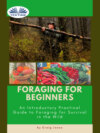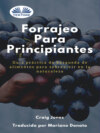Kitabı oku: «Foraging For Beginners», sayfa 2
Hazards of Foraging
Foraging may have many benefits, but dangers also exist. Some problems one may encounter are:
1 Poisoning oneself: This occurs when a person eats a poisonous plant or handles a toxic plant. Therefore, take extra care. Some poisonous plants can cause dizziness, nausea, seizures, and even death. So, though foraging may be fun, it is not a light affair.
2 Destroying the environment: The excitement of foraging may make us forget that the environment thrives on the preservation of these wild plants. Stomping through the wild and destroying plants or harvesting more than necessary or taking the only plant in an area is essentially destroying the environment. Wild animals need some of these plants to survive more than we do. So, we should take care when foraging to carry only what is necessary and leave the rest for other foragers and wild animals.
3 Going against the law: Foraging is a delightful activity but shouldn't contravene any laws. It's easy to trespass or forage on prohibited grounds if one is not careful. This can lead to an arrest or worse, a conviction. So, you need to be sure that where you're foraging is safe ground.
4 Dealing with unusual foods: Depending on the person you are, this may be a welcome challenge. Others will steer clear of the unusual. Wild foods, as with all foods, have their preparation process, and this may involve days or weeks to get the product edible. Do not despair, patience is key when dealing with all things wild.
Chapter 2
Types of Equipment to Use for Foraging

Before you get all excited and start outdoors, let’s talk about your foraging gear. What to wear, what to carry, what to use; we will extensively discuss these.
For our purposes, we’ll divide these types of equipment into four kinds, protective gear for you, tools to assist you with harvesting plants, storage for different plants, and the miscellaneous.
Protective Gear for You
Wear Loose, Comfortable Clothing
When taking on a foraging mission, make sure you wear comfortable clothes. Comfortable means clothes that are easy to move around with, because you’re going to do a lot of bending, stretching, and sometimes, kneeling. You’d want to wear clothes that don’t inhibit your movement.
Long pants will protect your legs from insects and a long-sleeved shirt. And on days when the weather is colder, you can add layers of clothing to keep you insulated. A pair of socks too will prevent your feet from blistering when you have to take long walks.
Wear Boots
Nature’s beautiful, but not tender. Boots protect your feet from thorns and sharp sticks. They’re also essential in wet, swampy areas where you may have to trudge through mud, you definitely wouldn’t want to dirty your feet. Boots will protect you from crawling insects like scorpions. They won’t be able to chomp through your boots and get to your feet.
Wear a Wide Hat
In sunny areas, it’s always advisable to carry a hat. All edible wild plants don’t grow in the same area, so you may need to do a lot of walking to get to them. Nothing is more off-putting than the sun beating down your back when you’re trying to concentrate, so get a hat.
Raincoat or Poncho
In rainy climates, it’s advisable to wear a raincoat or poncho. Possibly, you may spend more time foraging than you initially projected, so you must be prepared just in case it rains.
Gloves
A pair of thick leather gloves will protect the hands while picking thorny plants or possibly poisonous leaves. Plants like nettles, blackberry stems, poison oak or ivy, and poison sumac are harmful to the bare skin. Gloves would protect the hands when handling these. Just wash your gloves properly after you handle any toxic plant.
First Aid Kit
In case you sustain a cut, a basic first aid kit can be handy for cleaning and dressing a wound until you can get the proper care.
Bug Spray
Bug spray is an insect repellent that you can apply on your skin or surfaces to discourage insects from perching. Using bug spray on your body should protect exposed parts from mosquitoes, ticks, and other creepy crawlies because they are many in the wild. You can reapply insect repellent, but do it after 6 hours or more.
Sunscreen
Of course, we can’t leave out the sunscreen. As earlier pointed out, foraging is going to take a while in the sun, and to protect your skin from the ill effects of the sun, apply some sunscreen.
Common Tools for Harvesting Plants
Although it is possible to forage plants with your hands, there are a few special tools that can make the process a lot easier especially when dealing with some roots and certain kinds of plants.
Foraging Guide
When going out to forage, a field guide is going to be an essential tool to be armed with. This is super important. You'd need to be sure that what you're picking is the right plant. Edible plants look similar to toxic ones, so you'd have to be completely certain before plucking them. They may grow side by side, so you must have a guide or more to direct you on what to pick. Make sure you get a guide that is specific to your region.
Knife
A knife is every foragers' essential. It can be a small knife for sniping off simple leafy greens or a chopping knife that can cut through dense, thicker roots.
Trowel/Shovel
A trowel or shovel can dig up roots. You can use a sharp stick, but it's always best to have your tools at hand. It saves you time, and you don't have to soil your hands by digging with your fingers.
Magnifying Glass
A magnifying glass will aid you in spotting the micro features of plants. There are things your eye won't pick up that would be important in determining whether a plant is edible, so a magnifying glass is very useful.
Clipper
A clipper, like a small knife, is an easy tool to use in sniping off tender leafy plants.
Scissors
You can use a pair of scissors in place of a clipper or small knife. It's handy and easy to use to cut off soft stems.
Brush
A vegetable brush can clean roots before packaging them. Just brush off the sand and have a cleaner root. Of course, you may use your gloved hands, but that's just more work and it will be better if you direct your energy to something profitable–like picking more plants.
Storage for Different Plants
Containers
It won't do to get your plants then have no place to put them. Having special containers is very important. For instance, berries can get squished if pressed so flat plastic Tupperware will work well.
Basket
A cute basket will work for the storage of roots like hickory, burdock root, and wild potatoes.
Sealable Bags
Sealable bags can be paper bags or any bag that allows air to seep through. A bag that is too tight or hot may kill green leaves in a short time. So an airy bag will allow the leaves to breathe and stay fresh.
Water
Heat dulls the color of leaves and weakens them so you can pour water into a plastic bag to keep the leaves fresh. You can also wash your hands and fruits before eating.
Others
Camera or a Smartphone
A camera to take shots of your wild edible plants or to do more research is important. You can also keep a documentary of the areas you have foraged for memory’s sake or as a guide to go there again.
Notebook and Pencil
A notebook and pencil can jot down thoughts or views or discoveries of which you’ll have many. So don’t forget to take those.
Snack
You’d grow hungry and no, you can’t eat the next green leaf you see. We can’t let hunger lead you to eat something potentially harmful. Take snacks and plenty of water, foraging takes time.
Backpack
And, of course, you need a backpack to put in all your equipment.
So, this is a basic list. You may not need to take all the listed items, you should rather add some which are unique to your needs, just really be sure about what you want to accomplish on your forage and take the tools that’ll help you do a good job.
Ücretsiz ön izlemeyi tamamladınız.












